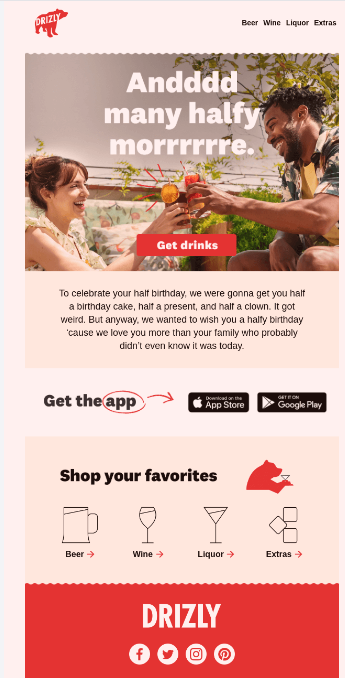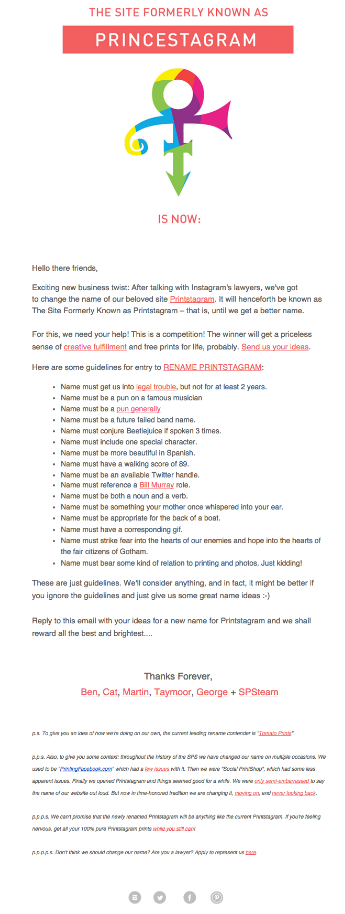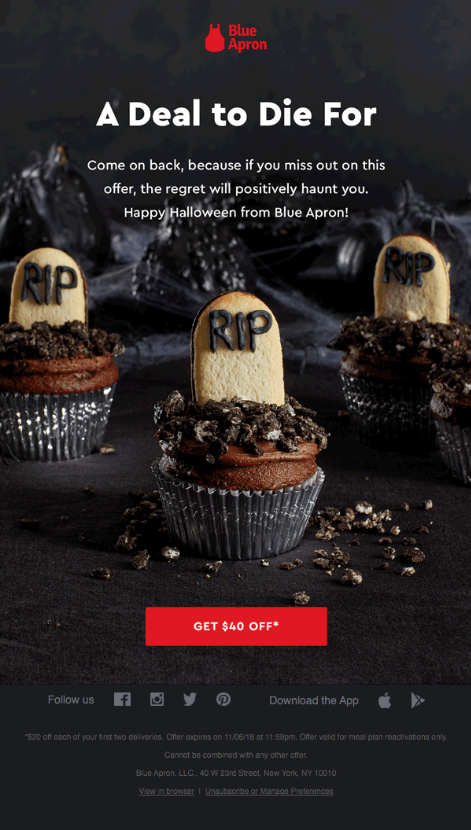Have you ever received an email that made you laugh? Chances are, you remember that email pretty well.
Humor can transform a routine email into an engaging and memorable experience, strengthening your bond with your audience. Funny emails can boost open and click rates, leading to higher engagement and conversions.
Research shows that 91% of consumers prefer funny brands, and 69% are more likely to open emails with funny subject lines.
That said, mastering the appropriate style of humor is an art. Poorly executed jokes can fall flat or turn people off. However, when executed skillfully, funny emails immediately catch people’s attention, leaving them curious to read more.
In this guide, we’ll share expert tips to craft funny emails for marketing to engage your audience and maximize campaign results. We’ll also analyze funny email examples to give practical tips for your next campaign.
Seven funny email examples for inspiration
Crafting compelling, funny emails for your marketing campaigns involves balancing humor and advertising. Here are seven examples of brands successfully connecting with their audience through humor.
1. Drizly - “Halfy birthday to you”
You can expect a broad smile flashing on the recipient’s face when you wish them a ‘halfy birthday’. Drizly has found a funny yet thoughtful way to create a celebration and grab their subscribers’ attention.
This email’s cheerful imagery and playful text immediately set a humorous tone. The clean copy provides links to specific products for a smooth buying process.
The bold CTA button in red seems to raise a toast for the celebration while not being too pushy. As a personalized email, the recipient is bound to be impressed and take the desired action.

Image via Really Good Emails
2. Who Gives A Crap - “Rarely asked questions”
The email from the eco-friendly toilet paper company, Who Gives A Crap, takes a playful approach. It presents a series of unexpected questions, followed by witty responses. This style grabs the reader’s attention and sets an entertaining tone.
This self-deprecating humor pokes fun at the company’s product while highlighting its unique brand personality. A clear and prominent CTA button, “Where can I buy TP?” directs readers to the product page.
The email is visually appealing, with a light pink background and bright orange text that catches the eye. The inclusion of an adorable photo of a dog further enhances the email’s charm and relatability.

Image via Really Good Emails
3. Surreal - “All hell breaks loose”
The funny email from Surreal is a prime example of using humor to engage customers and promote a product. The dramatic headline immediately catches the readers’ attention, compelling them to read further.
Using supernatural, spooky themes to promote a cereal brand is very unexpected, which makes the email memorable. The design is visually appealing as it includes clear sections that are easy to read.
The main and secondary CTAs are boldly displayed, and the copy reinforces urgency and prompts immediate action. Surreal’s email will captivate its audience, create a buzz, and leave a lasting impression.

Image via Really Good Emails
4. Social Print Studio - We have to change our name
Printstagram, owned by Social Print Studio, sent an email asking subscribers to suggest a new name for its rebrand. The “guidelines” for entries are a long list of humorous and contradictory rules that make fun of the naming process.
This shows that funny emails can be an effective marketing tactic. In this case, email helps build stronger customer relationships during the rebranding. The use of humor makes the email stand out and feel more personalized.
By making a call for new name ideas but with funny rules, the brand shows its playful side. Instead of a dry corporate update, it becomes an entertaining CTA that increases customer investment in the brand’s future.

Image via Really Good Emails
5. Blue Apron - “Forget the candy, this deal is the sweetest one yet!”
There are plenty of opportunities to send funny emails to customers throughout the year. Halloween is a particularly good time because people tend to expect such emails from brands during this time of the year.
The subject line of the Blue Apron email playfully grabs attention. The image is hilarious, making the email visually appealing and memorable. The CTA highlights the offer, encouraging subscribers to take immediate action.
Although it seems quite simple, much effort must have gone into the creation and execution. All elements in this funny email work together—the image, subject line, and main text—to effectively deliver the brand’s marketing message while making the audience chuckle.

Image via Really Good Emails
6. FitVine - “For Father’s Day, here’s 15% off (and some real good dad jokes)”
You don’t need to spend much time brainstorming funny email ideas. Evergreen jokes can work well in the right context.
For example, FitVine, a low-sugar wine brand, used “dad jokes” in their Father’s Day funny email. Pairing these dad jokes with their wine promotion makes it both entertaining and on-brand.
The visuals of wine bottles complement the humor, making the email more memorable and shareable. For a brand like FitVine, using playful, family-friendly humor is a great way to connect with customers.
The email offers a clear and straightforward deal with a specific validity period. A prominent CTA button links directly to the product page, encouraging readers to take immediate action.

Image via Really Good Emails
7. REP Fitness - “Punk your swolemate in the name of love ❤️”
Giveaways and promotions can be presented humorously to capture attention and drive conversions. This REP Fitness email features the “Prank Your Swolemate” giveaway.
The email outlines step-by-step instructions for a prank. They’re easy to follow because the rich visuals clearly show the reader what to do. The email’s funny tone entices readers to participate.
Clever viral marketing involves encouraging subscribers to interact with your website and social media platform in a fun, interactive way. This approach boosts engagement and strengthens brand loyalty by creating memorable experiences.

Image via Really Good Emails
Best practices for crafting funny emails for your campaigns
Funny emails add a personal touch to your marketing and help build an engaged audience. However, ensuring the humor is well-received requires a careful approach. Follow these best practices to craft effective, funny email campaigns.
Aligning humor with your brand’s identity
Using humor in emails can be fun, but ensuring the jokes align with your brand’s identity is essential.
If your brand has a more serious or formal tone, it’s best to use humor sparingly and subtly. However, if your brand has a more playful or casual personality, you can incorporate more overt humor.
Here are some guidelines to balance humor and professionalism in your email marketing campaigns:
- Set boundaries: Identify off-limits topics, language, and types of humor for your brand.
- Review process: Have multiple people vet the humorous content before sending it out to ensure it fits and doesn’t go too far.
- Use humor strategically: Make sure the humor reinforces your main message, not just for laughs.
The goal is to strike the right balance—using humor purposefully and moderately to engage your audience.
Understanding what your audience thinks is funny
Humor is subjective, so understanding what jokes your audience enjoys is crucial. Start by gathering data on your audience’s demographics, interests, and cultural backgrounds.
Here’s how to gather relevant data:
- Check website analytics to identify the demographic breakdown of visitors.
- Gather information collected during the signup process, such as age, gender, and location.
- Look at what content/products they engage with most on your site.
- Check the accounts they follow/share on social media related to your brand.
- Have them answer a survey to learn more about their hobbies, areas of interest, and cultural values.
Once you have these insights, you can test different humor styles, tones, and topics. Continuously refine your strategy based on open rates and engagement metrics.
Crafting the message
Well-written funny emails should enhance your main message, not overshadow it.
Here are some tips to complement your funny email ideas:
- Use wordplay: Incorporate puns, rhymes, play on words, or funny twists on common sayings. For example, you can use “Donut Miss This Sale” for a bakery promotion.
- Exaggerate for effect: Hyperbole can make something seem outrageous or silly in an amusing way. For example, describing a small discount as “The sale of the century!”
- Try unexpected humor: Surprise the reader by mixing opposite ideas or adding jokes in surprising places. For a tax preparation service, you could open with, “Lucky you, it’s tax season again! No need to thank us for the yearly joy.”
- Experiment with CTAs without deviating: Instead of a standard “Buy Now,” try a clever twist to your CTA like “Treat Yo’ Self” or “Indulge Your Desires Now.”
- Don’t go overboard: A couple of well-placed jokes are usually enough. Too many puns or attempts at humor can quickly become overwhelming.
Design elements that enhance humor
To make your funny emails stand out, think beyond just funny language. A smart combination of the right design elements can greatly enhance the overall appeal of your email campaign.
Consider the following design elements to boost your campaign’s effectiveness:
- Images and GIFs: Use funny pictures, memes, hover animations, moving GIFs, or mini-games to grab attention and reinforce humor.
- Font choices: Experiment with playful fonts for headings or to emphasize certain words.
- Layout and spacing: Break up text blocks with spacing and visual elements to make your email easier to read.
- Color palette: Use bright, unexpected colors that match your brand to create energy and excitement.
Timing and relevance of humorous emails
The best times to send funny emails are around holidays and seasons like Halloween, April Fool’s Day, or summer. People are usually in a more relaxed, fun mood during these times.
It’s good to connect the humor to current events or pop culture moments people are discussing, as this makes the jokes feel fresh and relevant. However, avoid joking about serious or tragic events, as that would be insensitive.
Holidays and seasons provide built-in funny themes to play off, like graveyard jokes for Halloween. However, don’t go too far with inappropriate humor. The key is using humor that matches the tone of current events.
Interactive and engaging content
Adding interactive elements to your funny emails is a great way to boost engagement. You can include things like:
- Polls or surveys: Instead of boring yes/no questions, give people silly multiple-choice answers to vote on.
- Quizzes with humorous scenarios: Create a quiz with funny imaginary situations. Let people choose the funniest outcomes.
- Clickable jokes or stories: Write a funny joke or story, only revealing the punchline if people click a button or link.
- Games or puzzles: Simple games, word puzzles, or brainteasers with humorous twists can be delightful surprises.
Segmentation and personalization
To improve your funny emails, you can add a touch of personalization. Segment your audience into groups and tailor the humor based on their interests and backgrounds.
Here’s how to implement this:
- Location: Use cultural references and local humor to make your emails more relatable.
- Age: Younger audiences enjoy memes and internet slang. Older people prefer witty remarks or classic jokes.
- Past engagement: Those interacting more with your previous emails might be more open to humorous content because they already know what to expect.
- Purchase history: Tailor your humor to reflect the products or services a segment has shown interest in.
- Interests and hobbies: Match jokes to their interests, such as tech jokes for those interested in technology.
Testing and refining humor
Test different humorous elements to understand what’s clicking with your audience.
Here are some methods to do this:
- A/B test jokes or punchlines: Send two versions of the same email with different jokes to see which resonates better.
- Try different types of humor: Test puns, memes, and jokes based on everyday life. See which one gets the best response.
- Mix up humor placements: Place jokes in different sections, such as subject lines, openers, or closers, to find the ideal spot.
- Adjust humor levels: Send some emails with lots of humor and others with just a touch to find the right balance.
Analyze metrics like open rates, clicks, subscribes/unsubscribes, conversions, and overall engagement. Let the data guide your optimization.
Feedback collection and adjustment
While data is useful, direct feedback from subscribers offers invaluable insights.
Here’s how to gather it:
- Send simple surveys after funny email campaigns to rate the appropriateness of the jokes.
- Include a survey link in your funny emails to allow subscribers to provide feedback.
- When conducting social media listening, watch out for any feedback about your funny emails.
- Invite some engaged subscribers to small focus groups to evaluate the humor in your emails.
Feedback lets you hear directly from subscribers about what humor landed well and what missed the mark. Use this feedback to refine your humorous email strategies to match your audience’s tastes better.
Legal and ethical considerations
When adding humor to your emails, keep these points in mind to ensure they’re legal and ethical:
- Truth in advertising: Ensure all humorous claims about your products or services are accurate and not misleading.
- Intellectual property: Don’t use copyrighted images, memes, or pop culture references without permission.
- Discrimination laws: Don’t use jokes that might offend any group based on race, gender, or disabilities.
- Opt-out compliance: Make it easy for recipients to unsubscribe if they don’t appreciate the humor.
Funny emails: Wrap up
When done right, incorporating humor into your marketing campaigns can yield remarkable results. Funny emails capture attention, build connections, and boost conversions better than mundane marketing emails.
Making customers smile, chuckle, or even laugh out loud positions your brand as fun, relatable, and approachable. It allows you to be creative while showing that there are real people behind the messages.
Pulling off funny marketing emails takes skill and thoughtful planning, but it’s worth it. With constant practice, you can breathe life into your email campaigns and become a brand customers can’t get enough of.
